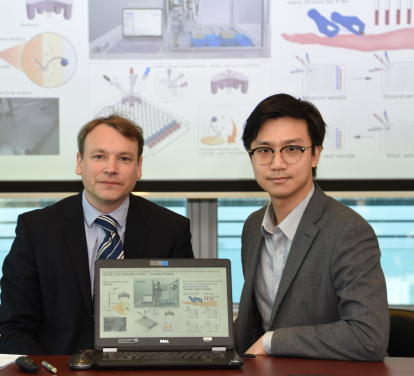Media
HKU and Imperial College London Develop the First Robotic
Aptamer-based Platform for Hormone Pulsatility Measurement,
Enabling Better Diagnosis of Reproductive Disorders
21 Feb 2019

Dr Julian Tanner (left) and Dr Shaolin Liang explained that the new robotic platform technology which measures hormone pulse patterns in reproductive disorder patients is the first demonstration of this technology which is expected to be widely applied to a wide range of diagnostic scenarios in the future.
Many reproductive disorders are caused by altered pulse patterns of hormone secretion in the blood stream, leading to a variety of reproductive disorders such as polycystic ovary syndrome (PCOS) and hypothalamic amenorrhaea. Such disorders are very common with PCOS having a prevalence of 5-7% of all reproductive-age women. There are a wide variety of complications of such reproductive disorders such as infertility, metabolic syndrome and depression. There is a frequent challenge to the diagnosis of these disorders as single measurements from a blood sample cannot tell a clinician the pulse pattern of hormone secretion over time.
The LKS Faculty of Medicine of The University of Hong Kong (HKUMed) has collaborated with Imperial College London to develop and apply a new robotic platform technology to measure hormone pulse patterns in reproductive disorder patients. This is the first demonstration of this technology which is expected to be widely applied to a wide range of diagnostic scenarios in the future. The research has just been published in Nature Communications, a top journal in the field of multidisciplinary science. (link to the publication)
One of the lead researchers of the study, Dr Julian Tanner, Associate Professor of the School of Biomedical Sciences, HKUMed, remarked, “Diagnosis of reproductive disorders that often cause infertility is a long-standing challenge. This study provides an innovative underlying biomedical technology that has the potential to transform medical diagnostics through enabling repeated or even continuous measurement of hormone and other biomolecule concentrations.”
Study Results
The team developed and applied an entirely new approach for measuring the pulse pattern of one of the important hormones to be analysed for diagnosing patients with reproductive disorders - luteinising hormone. A short piece of DNA, known as an aptamer, which specifically bound to luteinising hormone without binding to other closely related hormones was developed. The team integrated this aptamer onto an electrochemical detector so that when the aptamer changed shape in the presence of the hormone, the electrical properties of the surface changed, enabling a direct measurement of the concentration of the hormone in a blood sample. This electrochemical detector was integrated into a wire on a robotic platform so that hundreds of blood samples could be easily measured in parallel. The team then developed a new mathematical approach termed Bayesian Spectrum Analysis to determine the LH pulsatile pattern in a variety of clinical scenarios.
The significance of this study includes: 1) development of a novel molecule (aptamer) for luteinising hormone sensing; 2) development of a low-cost, efficient robotic platform for automated measurement; 3) development of a novel mathematical method for characterising luteinising hormone pulsatile information; and 4) validation of the performance of the platform with clinical samples in 3 patient cohorts in different LH pulsatility status (around 441 samples).
is amongst the first ever studies where aptamers have been used for diagnosis in a clinical setting. Antibodies are the usual approach for specific biomolecule measurements, but they cannot be used continuously so are not ideal for a new wave of biomedical technology in this area. Aptamers are ideal for continuous sensing technologies such as for biochips that might be embedded or may act via microneedle patches or tattoos in the skin in the future. Therefore, this research opens up significant possibilities as the underlying technology for continuous biomolecule sensing that could transform molecular diagnostics.
Previous Study Results
Over the last decade, the HKU team has been developing the use of aptamers for new approaches for diagnostics, particularly for the point-of-care diagnosis of malaria. Previous studies had been published in Proceedings of the National Academy of Sciences in 2013 for aptamer-mediated diagnosis of malaria. Subsequently, the team developed a wide variety of point-of-care tests for malaria as published in Chemical Communications in 2015, ACS Sensors in 2016 and Biosensors & Bioelectronics in 2018. This is the first study where they have extended the impact of aptamer biomedical technology to diagnosis of reproductive disorders.
About the research team
The current study was led from both HKU and Imperial College London. The three lead investigators are Dr Julian Tanner, Associate Professor of the School of Biomedical Sciences, HKUMed, Professor Waljit Dhillo, Professor of the Section of Endocrinology and Investigative Medicine, Imperial College London, and Professor Anthony Cass, Professor of the Department of Chemistry, Imperial College London. Dr Shaolin Liang was the first author as a joint PhD student between HKU and Imperial College London. Other researchers included Dr Raymond Li, Associate Professor of the Department of Obstetrics & Gynaecology, HKUMed, together with other collaborators at the University of Exeter and University of Bristol in the UK and at the Mayo Clinic in USA.
Acknowledgment
The Hong Kong aspects of this work were substantially supported by research grant 03142546 from the Health and Medical Research Fund (HMRF) of the Research Fund Secretariat of the Food and Health Bureau. Funding was also provided by the NIHR Imperial Biomedical Research Centre, an Imperial-Hong Kong PhD studentship and an NIHR Research Professorship.
Media Enquiries, please contact:
Please contact LKS Faculty of Medicine of The University of Hong Kong by email (medkefa@hku.hk).
